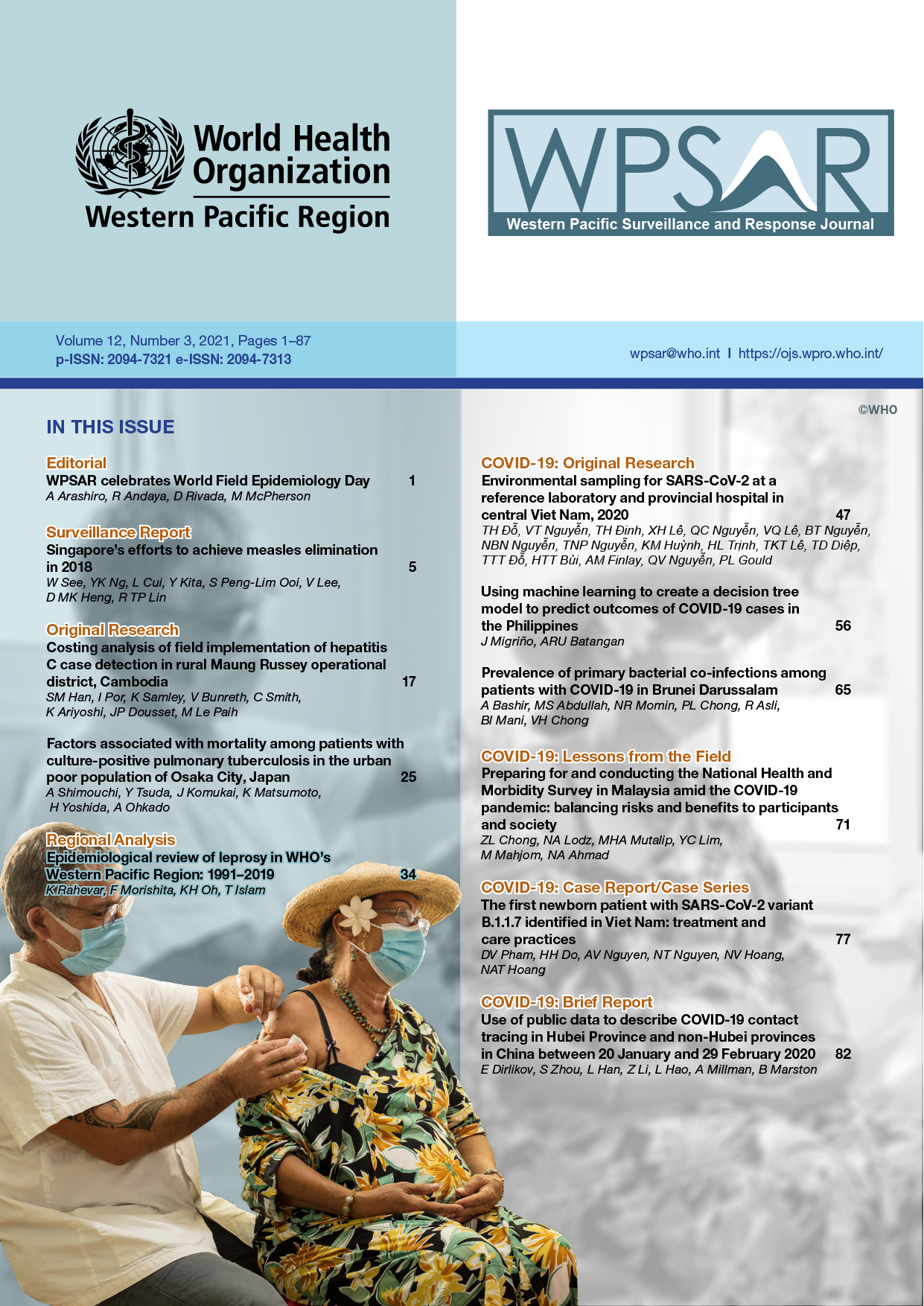Environmental sampling for SARS-CoV-2 at a reference laboratory and provincial hospital in central Viet Nam, 2020
DOI:
https://doi.org/10.5365/wpsar.2020.11.4.002Abstract
Objective: To determine whether environmental surface contamination with severe acute respiratory syndrome coronavirus 2 (SARS-CoV-2) occurred at a provincial hospital in Viet Nam that admitted patients with novel coronavirus disease 2019 (COVID-19) and at the regional reference laboratory responsible for confirmatory testing for SARS-CoV-2 in 2020.
Methods: Environmental samples were collected from patient and staff areas at the hospital and various operational and staff areas at the laboratory. Specimens from frequently touched surfaces in all rooms were collected using a moistened swab rubbed over a 25 cm2 area for each surface. The swabs were immediately transported to the laboratory for testing by real-time reverse transcription polymerase chain reaction (RT-PCR). Throat specimens were collected from staff at both locations and were also tested for SARS-CoV-2 using real-time RT-PCR.
Results: During the sampling period, the laboratory tested 6607 respiratory specimens for SARS-CoV-2 from patients within the region, and the hospital admitted 9 COVID-19 cases. Regular cleaning was conducted at both sites in accordance with infection prevention and control (IPC) practices. All 750 environmental samples (300 laboratory and 450 hospital) and 30 staff specimens were negative for SARS-CoV-2.
Discussion: IPC measures at the facilities may have contributed to the negative results from the environmental samples. Other possible explanations include sampling late in a patient’s hospital stay when virus load was lower, having insufficient contact time with a surface or using insufficiently moist collection swabs. Further environmental sampling studies of SARS-CoV-2 should consider including testing for the environmental presence of viruses within laboratory settings, targeting the collection of samples to early in the course of a patient’s illness and including sampling of confirmed positive control surfaces, while maintaining appropriate biosafety measures.
References
Phan LT, Nguyen TV, Luong QC, Nguyen TV, Nguyen HT, Le HQ, Nguyen TT, Cao TM, Pham QD. Importation and Human-to-Human Transmission of a Novel Coronavirus in Vietnam. N Engl J Med. 2020;382:872-874. DOI: 10.1056/NEJMc2001272.
Ministry of Health of the Socialist Republic of Vietnam’s COVID-19 situation dashboard. https://ncov.moh.gov.vn/. [cited on 2020 Aug 26]
van Doremalen N, Bushmaker T, Morris DH, Holbrook MG, Gamble A, Williamson BN, et al. Aerosol and surface stability of SARS-CoV-2 as compared with SARS-CoV-1. N Engl J Med. 2020;382:1564–7. DOI: 10.1056/NEJMc2004973.
Chin AWH, Chu JTS, Perera MRA, Hui KPY, Yen H-L, Chan MCW, et al. Stability of SARS-CoV-2 in different environmental conditions. Lancet Microbe. 2020;1:e10 DOI: 10.1016/S2666-5247(20)30003-3.
Jiang FC, Jiang XL, Wang ZG, Meng ZH, Shao SF, Anderson BD, et al. Detection of severe acute respiratory syndrome coronavirus 2 RNA on surfaces in quarantine rooms. Emerg Infect Dis. 2020; 26(9):2162-2164. DOI: 10.3201/eid2609.201435.
Chia PY, Coleman KK, Tan YK, et al. Detection of air and surface contamination by SARS-CoV-2 in hospital rooms of infected patients. Nat Commun. 2020;11(1):2800. DOI:10.1038/s41467-020-16670-2.
Wu S, Wang Y, Jin X, Tian J, Liu J, Mao Y. Environmental contamination by SARS-CoV-2 in a designated hospital for coronavirus disease 2019. Am J Infect Control. 2020;48:910–4. doi:10.1016/j.ajic.2020.05.003
World Health Organization. Surface sampling of coronavirus disease (COVID-19): a practical “how to” protocol for health care and public health professionals. 2020 February 18. (WHO/2019-nCoV/Environment_protocol/2020.1) @ https://www.who.int/publications-detail/surface-sampling-of-coronavirus-disease-(-covid-19)-a-practical-how-to-protocol-for-health-care-and-public-health-professionals
Corman VM, Landt O, Kaiser M, Molenkamp R, Meijer A, Chu DK, Bleicker T, Brünink S, Schneider J, Schmidt ML, Mulders DG, Haagmans BL, van der Veer B, van den Brink S, Wijsman L, Goderski G, Romette JL, Ellis J, Zambon M, Peiris M, Goossens H, Reusken C, Koopmans MP, Drosten C (2020). Detection of 2019 novel coronavirus (2019-nCoV) by real-time RT-PCR. Euro Surveill. 2020;25(3):pii=2000045. DOI: 10.2807/1560-7917.ES.2020.25.3.2000045.
Wölfel, R, Corman, VM, Guggemos, W et al. Virological assessment of hospitalized patients with COVID-2019. Nature 2020;581:465–9. https://doi.org/10.1038/s41586-020-2196-x.
World Health Organization. Laboratory biosafety guidance related to coronavirus disease (COVID-19), 2020 May 13. https://www.who.int/publications/i/item/laboratory-biosafety-guidance-related-to-coronavirus-disease-(covid-19).
To KK, Tsang OT, Leung WS, et al. Temporal profiles of viral load in posterior oropharyngeal saliva samples and serum antibody responses during infection by SARS-CoV-2: an observational cohort study. Lancet Infect Dis 2020;20:565–74. https://doi.org/10.1016/S1473-3099(20)30196-1.
Zheng S, Fan J, Yu F, Feng B, Lou B, Zou Q, et al. Viral load dynamics and disease severity in patients infected with SARS-CoV-2 in Zhejiang province, China, January–March 2020: retrospective cohort study. BMJ 2020;369:m1443. https://doi.org/10.1136/bmj.m1443.
Zou L, Ruan F, Huang M, Liang L, Huang H, Hong Z, et al. SARS-CoV-2 viral load in upper respiratory specimens of infected patients. N Engl J Med 2020;382(12):1177–9. https://doi.org/10.1056/NEJMc2001737.

